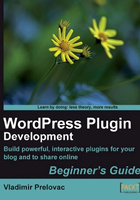
上QQ阅读APP看书,第一时间看更新
Summary
In this chapter, we created a working, useful, and attractive WordPress plugin from scratch. Our plugin now displays a fully functional Digg button.
We learned how to extract information using WordPress API and how to use CSS to improve the appearance of our plugin. We also investigated some more advanced WordPress functionalities such as hooks.
Specifically, we covered:
- Creating a plugin: How to fill in the information header and create a simple plugin template
- Checking WordPress version: How to check that our plugin is compatible with the user’s version of WordPress
- Modifying theme files: How to safely add functions to the theme files when we need to
- Accessing post information: Different ways of obtaining data from the post such as title, permalink and content
- Using WordPress hooks: How to use actions and filters to get things done from within our plugin (and not modifying the theme for instance)
Now that we've learned about WordPress hooks, we are ready to expand our knowledge and learn about Widgets. In the next chapter we will create a cool Wall widget for users to write comments directly on our blog sidebar.